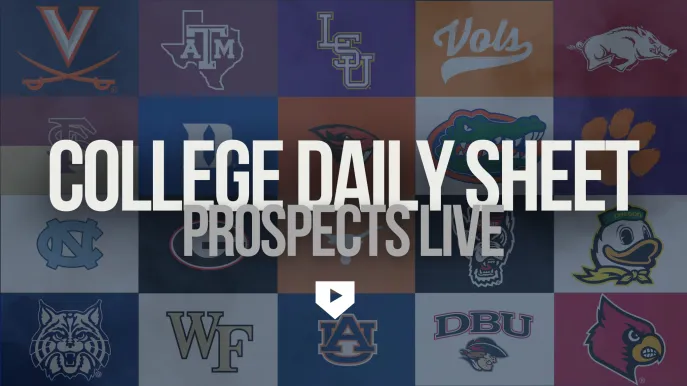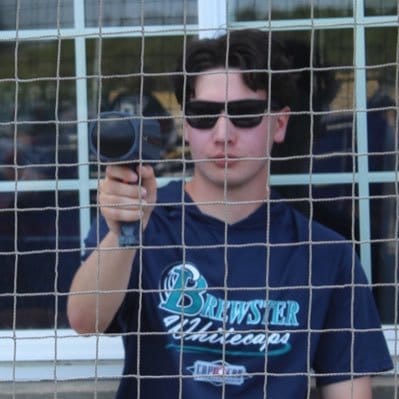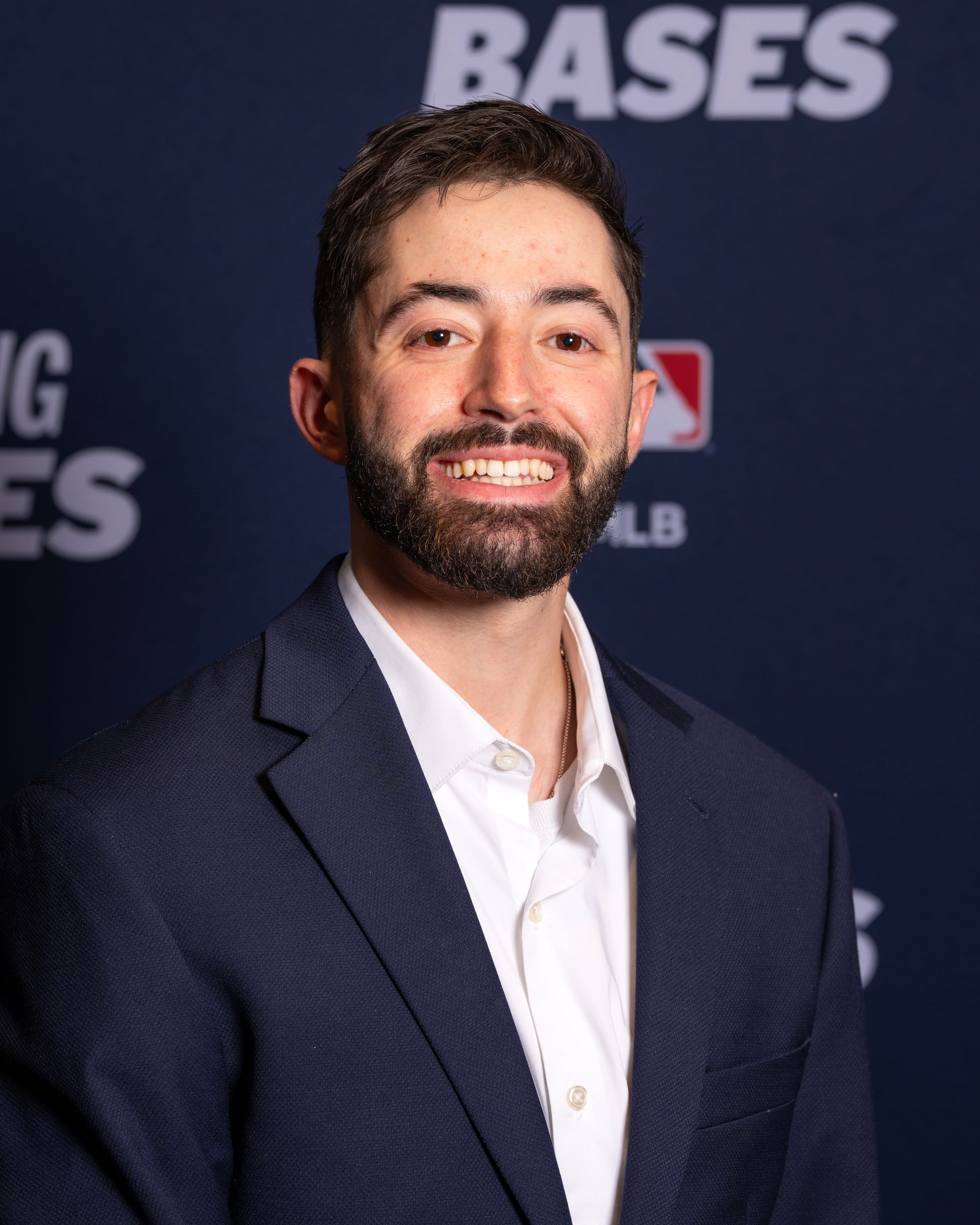Typically, we see future MLB players spend multiple years in the minor leagues. Even the most talented of prospects have to be thoroughly developed before they’re ready for the show. Baseball is a weird sport, simply put. It’s the only North American sport with a tiered minor league system, aimed at developing players one step at a time. Most minor league players never even sniff the MLB, with minor league baseball becoming increasingly more competitive and a huge step up from prep or college competition. Our focus for today’s study is the players who take an unusual path to the major leagues, skipping the minor leagues fully or just playing a handful of games before their MLB debut. Welcome to the fast track.
The scope of this study will focus on players who made their MLB debut the same year they were drafted, or before the All-Star break of the following year. In total, there have only been ~47 players to accomplish this feat since 1967. Most recent and notable, Cam Smith of the Houston Astros made his MLB debut on Opening Day 2025 after being the 14th pick in the 2024 draft. In this decade, we’ve seen the Angels take this approach with a staggering four players, with varying degrees of success.
Throughout this study, we’ll analyze how these fast-tracked players do compared to the typical MiLB-developed player. Historical trends will also be analyzed, as fast tracking typically comes in waves. Player archetypes will also be of importance, figuring out what type of players typically succeed in rushed development versus what kind of players struggle. Lastly, we’ll put all of this information together to figure out what these trends mean moving forward and why they happen in the first place.
EARLY DEBUT HITTERS
Hitters are much less likely to be fast-tracked than pitchers throughout history. Since 1978, all of our criteria-fitting bats have been drafted out of college. There have only been 6 hitters since 2010 to be fast-tracked, showing how rare it is in today’s era of baseball. Wyatt Langford and Cam Smith debuted too recently to draw full conclusions on, yet the former is bolstering the case to debut hitting prospects earlier.
NOLAN SCHANUEL
As we can see from the graphic, all fast-tracked hitters post-2001 spent at least some time in the minors. Nolan Schanuel has the rarest modern path, with him debuting the same year he was drafted. Schanuel has put up 1.3 WAR throughout his career, displaying that even the highest-level college bats will struggle in MLB. Schanuel has extremely high contact rates, giving him a higher floor than most, yet there is little upside for Schanuel’s future development against MLB pitching. If Schanuel had spent a year or two in the minors, he might have been able to make more adjustments to become a more well-rounded player before his debut.
DAVE WINFIELD
Pre-2000, there were varying levels of success for fast-tracked hitters. Dave Winfield was able to make the jump straight from college to the bigs, ending in the Hall of Fame. Winfield still struggled out of the gate, and through his first three years, he only had 4.2 WAR before ending his career with 64.2. Those first three years for Winfield were filled with ups and downs and development that we would normally see at the minor league level. Being allowed to fail against MLB pitching likely helped Winfield down the road in his career.
BOB HORNER
Bob Horner was one of the most successful in his jump directly from college to MLB. Horner won the Golden Spikes award at Arizona State in the Spring and then won the Rookie of the Year award while only playing the second half of the 1978 season, putting up 2.1 WAR in that short time. Horner collected 8.8 WAR across his first three seasons, second-best on this list. His career was ultimately cut short due to injuries, but Horner displayed the high level of polish needed to succeed immediately at the MLB level.
BRIAN MILNER
The only hitter to debut in MLB directly from High School was Brian Milner (Hoby Milner’s dad), a seventh-round pick in 1978 who was told he would immediately play for the big league squad. He played in two total games before being sent down to rookie ball, never to play in the MLB again after injuries ended his career. Milner’s example can be chalked up to MLB's instant need, rather than a team choosing to fast-track a big-time prospect for development reasons.
KYLE SCHWARBER
One of the most notorious names on this list, Kyle Schwarber was pushed quickly through the minors, making his debut almost a year after he was drafted, barely fitting the criteria for this study. Schwarber had enough time in the minors to develop his bat more, resulting in success at the big league level quickly. Schwarber’s modest 10 career WAR does not paint the full picture for him, with his poor defense anchoring down his WAR numbers. Schwarber hit 16 home runs in his half-season debut to the tune of a 131 wRC+. Schwarber is near the top of the list for debut success for a fast-tracked player. His power mixed with plate vision is an interesting discussion for player archetype success.
ZACH NETO
Zach Neto debuted early in the season following his draft year. Neto filled an extreme need for the Angels at the shortstop position, providing a high floor with strong defense up the middle. Neto’s bat developed a lot during his second MLB year, hitting 23 home runs while maintaining good defense at shortstop, putting up 3.5 WAR. Neto appears to be a fast-track success story thus far.
ROBIN YOUNT
Robin Yount is one of the premier names on this list, compiling a Hall of Fame career while being one of two hitters to make the jump from High School to the MLB in less than a year. Yount got about 60 games to develop in the minors before getting the call. The Brewers let Yount develop in the major leagues, citing his generational talent for the aggressive promotion. Letting Yount struggle in the majors for a bit allowed him to become a superstar just a few years later.
JOHN OLERUD
John Olerud compiled the most WAR through his first three seasons of anyone on this list at 9.4. Olerud was one of the most polished college bats we’ve seen over the years, coming from Washington State. He had a plus-plus hit tool with enough power to play every day, giving him the same high floor as many of these other players.
RYAN ZIMMERMAN
Ryan Zimmerman is the most successful post-2000 player to make the instant jump from college to the pros. He played in only 4 minor league games before getting the call. Zimmerman was an elite college talent with both the bat and defensively, being one of the most polished college hitters ever drafted. Zimmerman put up 9 WAR throughout his first three years despite being only 20 years old at his MLB debut.
CONOR GILLASPIE
Conor Gillaspie was promised a September debut as part of his signing, something that we’ll also see in some of our pitchers. There are often ulterior motives that aren’t talent-related for players' early debuts.
ANALYSIS
The majority of these fast-tracked hitters were college standouts and early draft picks. Long-term success has varied within the group, in a similar fashion to players who were developed regularly in the minors. The majority of these players did not make an early impact for their teams, instead breaking out after their first few years in the MLB. There is little evidence that rushing hitting prospects guarantees any different kind of development from that in the minors. Allowing a player to fail in the MLB rather than the minors can be seen as a positive for future development, as seen in older guys like Yount and Winfield, yet it shows no success in the modern age. Further conclusions will be made at the end of this article.
EARLY DEBUT PITCHERS
It is much more common to see a pitcher be fast-tracked than a hitter; most often, these are polished college arms that are frequently starters. There are more modern examples of pitchers being fast-tracked than hitters, allowing us to draw more conclusions.
Many of these players were initially used as relievers in the majors, regardless of whether they were starters in college. Teams have been shown to put these starters into relief roles to fill an immediate need on their MLB team, suggesting some teams are drafting out of current need when looking at elite college pitchers.
CHRIS SALE
Chris Sale is the standard for MLB teams filling an immediate reliever need from an elite starting pitching talent. After just 11 minor league games, Sale joined the White Sox bullpen for his first two years in the MLB. He quickly made the jump to starting in his third year, putting up a dominant 4.7 WAR. High velocity lefties with good stuff are a rare archetype in the MLB, so it makes sense the White Sox would want to use Sale immediately while trying to contend for a championship.
GARRETT CROCHET
Crochet took a nearly identical route as Chris Sale did with the White Sox, yet skipped the minors altogether. He is the same pitcher archetype as Sale, and after seeing Sale’s successful transition from the pen to starting, the White Sox did it again. Crochet spent three years in the bullpen before starting in his fourth year, also compiling 4.7 WAR just like Sale. Crochet is now a Cy Young contender with the Red Sox, showing that this type of fast-tracking works in the modern era.
HUSTON STREET
Huston Street is the most notable reliever in history to make the quick jump from college to the MLB, only playing 25 minor league games. Street won the AL Rookie of the Year during his debut year, closing for the Athletics. The early debut showed no signs of harming Street long term, sustaining his successes throughout his career.
BRANDON FINNEGAN
Finnegan is another true reliever like Street who was called up early. Finnegan made the jump to the MLB the same year he was drafted, filling an immediate need on a playoff team. Finnegan pitched 7 regular-season innings and 6 postseason innings in 2014. This early debut may have proved costly for Finnegan long term, being traded the following year and burning out after only 4 years. This brings up the argument of how important instant MLB need is compared to the long-term development of a player.
STEPHEN STRASBURG
Stephen Strasburg is the highest-profile prospect to ever make this kind of early debut in the MLB. He is also the most successful pitcher in terms of career WAR (32.3), outside of Chris Sale (53.1). Strasburg was ready for MLB competition when he debuted, putting up 1.9 WAR in 12 starts. The Nationals also used Strasburg as a way to fill seats, with all of his starts garnering more attention for the Nats. Strasburg was an elite pitcher when healthy and won a World Series MVP. He’s one of the biggest ‘what if they weren’t always injured’ pitchers in recent history.
MIKE LEAKE
Mike Leake is one of the rare starters to make the MLB without any minor league games played. Leake was good throughout his career, including a 2-WAR rookie season, yet he did not develop much throughout his career. Leake is one of the players on these lists that begs the question of ‘how would their career have turned out if they were allowed to develop in the minors?’
TREVOR BAUER
Bauer struggled in his first two professional years, making 4 starts for both the Diamondbacks and Cleveland without success. He did not find actual success until 2018 in his 6th MLB season, posting the only great season of his career. Bauer was a high draft pick who likely needed more time to develop in the minors before being thrust into the majors to fail.
BURT HOOTEN
Hooten took a similar path to Bauer, struggling through his first few years before breaking out later and having a solid MLB career.
KEVIN GAUSMAN
Gausman began in the pen for 15 appearances before making 5 starts in his debut year. He showed more instant signs of success as a starter than the previous Leake, Bauer, and Hooten, who were not given a relief opportunity. He did not achieve the instant stardom of Sale and Crochet when they transitioned to starting, instead taking a few years to become a Cy Young contender.
ANALYSIS
Starters typically struggle in their first few years before breaking out later. Strasburg is the modern exception. More success has been seen from college starters turned relievers turned back to starters a couple of years later. These players are given a chance to acclimate to MLB hitters without having to throw 100+ innings and face batters multiple times throughout a game. All signs point to finding high-velocity good-stuff players, putting them in the bullpen early if your team is contending, and then transitioning them back to a starter when there is an open spot a year or two down the line. In general, rushing true relievers to the MLB appears to hold no merit, with Street being the most successful true reliever to be rushed.
LOOKING AT DIFFERENT ERAS OF PITCHING
In the 1970s, we saw teams begin to rush pitchers to the big leagues often. Ruthven, Winfield (pitched early in his career), Clyde, and Bane all debuted in 1973, to varying degrees of success. In the late 1970’s Oakland debuted two high school players early, hoping to develop them in a new way, with both struggling out of the gate. Mike Morgan ended up having a long career, yet Tim Conroy never recovered. In the 1980s and 90s, we saw a decline in pitchers being fast-tracked, with only special talents like Jim Abbott doing so. Throughout the 2000s and 2010s, we saw pitchers only be fast-tracked under specific scenarios, those being relievers needed for pennant races, or young starters under careful watch. Finnegan is the most blatant example of the former, with Strasburg being the best example of the latter. Crochet and Sale are both success stories of drafting out of current need in the bullpen while also envisioning later success.
THE 2023 DRAFT CLASS*
Some notable names were left off this research due to the recency of their debuts. Paul Skenes, Wyatt Langford, and Rhett Lowder all fit our criteria, yet will not be found on any graphics or data from this study. They are, however, a good indicator that the MLB is becoming more open to fast-tracked players this decade.
SERVICE TIME DEBATES AND THE ANGELS' WEIRDNESS
Starting in the mid-2010s, service time began to be run like a science. Even the most polished top prospects spent over a year in the minor leagues, both to not rush their development and manage their service time clocks. Carlos Correa, Kris Bryant, and Gerrit Cole all could have likely debuted early in a different era, yet were held back during this time. The Angels began the resurgence of early callups, starting with Chase Silseth in 2021, who was an 11th-round pick seen as an experiment of sorts. They fast-tracked the previously mentioned Neto and Schanuel, as well as 2025 debutee Ryan Johnson, a reliever who skipped the minors entirely. The Angels are clearly displaying a different prospect philosophy than all other teams right now, and not in a good way. The Angels have not seen enough instant success from these players to warrant their rushed development, with no other teams following their methodology being a huge red flag. Teams like the Pirates were forced to debut Paul Skenes early due to his talent, similar to that of Strasburg. Rhett Lowder and Wyatt Langford are also examples of the immediate polish necessary to get an early promotion, something that none of the Angels players display to the same degree. If the Astros get a good rookie year from Cam Smith or Ryan Johnson dominates this year, we could see more teams willing to experiment with fast-tracking.
EARLY DEBUTS vs. TRADITIONAL PATHS
The biggest factor that separates fast-tracked players and traditionally developed players is their prospect pedigree. The majority of early-debuting players are high draft picks, with the majority being first-round picks. Inside the first round, the largest grouping of players can be found in the first five picks of the draft. This is where generational talents can often be found, leading teams to be more likely to push their top prospect faster. There is also a notable fan interest and ticket sales boost when a team's top prospect debuts, influencing teams to rush these guys.
With all of this being said, immediate success is far from guaranteed. The majority of fast-tracked players put up low WAR numbers in their first year, with some taking multiple years to achieve league-average marks for their position. It is extremely unlikely that a fast-tracked player will immediately become a star.
BAUER vs. GRAY
Comparing two 2011 draftees, we can see the stark difference in the two paths between Trevor Bauer and Sonny Gray. Bauer debuted less than a year after he was drafted, put up two negative WAR seasons before a 1.4 WAR third year, struggling mightily despite being seen as the better prospect between the two. Gray spent two years in the minors, debuting in August of 2013, where he put up 1.6 WAR in two months. Throughout Gray’s first three years, he collected 7 WAR, a prime example of a traditional path allowing a top prospect to skip some early career hiccups. This example is even more important as we have rarely seen fast-tracked starting pitching succeed early in their career.
MIKE ZUNINO
Mike Zunino is a great example of a hitting prospect debuting too early. Zunino was the 3rd overall pick in 2012 by the Mariners and debuted less than a year after he was drafted, likely trying to draw excitement toward middling baseball in Seattle. Zunino played well in the second half of 2012 across Single-A and Double-A, and began his 2013 in Triple-A, an aggressive move. He struggled at Triple-A compared to his standards, hitting just .227 with a concerning strikeout percentage near 30, something we hadn’t seen from him before. Despite these red flags, Zunino was promoted to the MLB, where he would post a 77 wRC+. While Zunino was known for his defense, if he had the time to develop his bat in the minors, his story could be a lot different. Instead, his career fizzled out in Seattle, and he hasn’t played in the MLB since 2023. When Zunino was healthy, he was a 4 WAR player off of his defense alone. If his bat had developed (a huge ‘what if’), we could’ve seen Zunino be one of the most valuable catchers of the 2010s.
When comparing WAR over the first three years for a fast-tracked player to a traditional player, we see very similar results for all positions and types of players. The benefit of the fast-tracked player is that you get their WAR contributions sooner than the traditional player. Many players struggle in their first few MLB years, regardless of how quickly they debut.
TRENDS BY ERA FOR ALL PLAYERS
Player debut trends have fluctuated by era since the MLB draft was established in 1965. Teams were hesitant at first, but by the early 1970s, teams were aggressively debuting their best players straight from college, and even sometimes from high school. In the late 1970s, teams began to take a more cautious approach as quite a few guys from the early 70’s flamed out and did not succeed after being fast-tracked. This caution remained for multiple decades until the early 2000s, when polished college position players were fast-tracked again, such as Rickie Weeks and Xavier Nady. College pitchers began being fast-tracked again in the late 2000s, with four pitchers debuting in less than a year between 2009 and 2010. This trend would continue into the 2010s until the aforementioned service time debate began around 2015. We didn’t see another player be fast-tracked until 2020 with Garrett Crochet, then in 2021, when the Angels began their run of early debuts. In the past few years, we have seen an uptick in players being fast-tracked.
ACHETYPES AND SUCCESS FACTORS
Through this research, certain player archetypes have been shown to be more successful than others. Some simple ideas would be that hard-throwing lefties with plus stuff and weird mechanics are successful early, like Crochet and Sale. We’re going to dig a bit deeper than that and examine what statistical measurements lead to early debut success.
THE GENERATIONAL ACE
This archetype could also be called ‘The Strasburg’. Other players who do not fit our early debut criteria yet fit the generational ace criteria are Jose Fernandez, Gerrit Cole, Paul Skenes, and Mark Prior. The key criteria for a player like this are a high strikeout% (11+ K/9), low walk rates (sub 3 BB/9), and multiple plus pitches according to stuff. The majority of these players are top picks or top international signings. There is a high injury risk in these players due to their heavy initial workload. Most of these players suffered major arm injuries early in their careers, yet were still able to perform post-injury. Even the worst outcomes for this criterion still end up with solid MLB careers, such as Ben McDonald, who ended his career with a 78-70 record and 3.91 ERA.
POWER ARMS READY FOR A PENNANT RACE
We have surprisingly seen the majority of fast-to-debut relievers succeed in the pursuit of a World Series. These players typically have electric stuff out of the bullpen or a starting role, highlighted by one standout 70+ grade pitch. Some examples of this archetype include Huston Street, Chris Sale, Garrett Crochet, and Brandon Finnegan (to a degree). The majority of these players employed their two best pitches most frequently, with the latter three being rare lefties out of the pen with plus stuff. The most telltale sign of this archetype is a high K rate accompanying an electric fastball/offspeed combo. A subset of this archetype is the starter turned reliever turned starter, as seen in Sale and Crochet. There is a bit of caution to be had within this group, as if you expand our scope to other quick-to-debut players, there are more misses. Joba Chamberlain, Craig Kimbrel, Ryan Wagner, and Craig Hansen are other names close to meeting the criteria for this archetype. While Kimbrel and Street were able to remain great closers, Wagner and Hansen fizzled out, and Chamberlain did not meet his lofty expectations when transitioning back to starting. The biggest risk within this archetype is that you end up stunting a guy that should be a starter's development, relegating him to a life of relieving, as seen with Chamberlain. The middle result for Power Arms Ready for a Pennant Race is still an extremely valuable player.
RELIABLE HITTERS WITH A PATIENT APPROACH
This profile features hit-first prospects that can draw walks and avoid strikeouts. These types of prospects often have the highest floor regardless of time to debut. The most glaring example of this player is Ryan Zimmerman, one of the most successful fast-tracked hitters. Other examples of this archetype are Alex Bregman, Wyatt Langford, and Andrew Benintendi, who debuted roughly a year after they were drafted. The statistics most often seen in these players are strikeout rates below 20%, walk rates above 10%, and high contact %’s. 60+ grade hit tools are a must, with average power elevating the player's ceiling (Benintendi vs Bregman). Low swinging strike rates are also a great indicator of fitting this archetype. Players have failed under this archetype, such as Khalil Green or Nick Madrigal, who couldn’t manage enough power to hold value. We have recently seen shades of this archetype in Nolan Schanuel, yet it is too early to tell if he will be a cautionary tale arguing against the merit of this section.
THE RUSHED PHENOM
This is our one archetype to stay away from. Luckily, MLB teams have been staying away from these for decades now. In the 1970s, we saw multiple prospects promoted straight from high school who were not ready for the MLB. David Clyde, Mike Morgan, and Brian Milner are all examples of why not to promote players directly from high school to the MLB without adequate time for development. Nowadays, high schoolers take multiple years in the minors to adjust to higher competition, whereas in the 1970’s teams were not so keen on waiting for guys to be ready.
Early debut players come in all shapes and sizes, but based on our sample, these archetypes are the best answer and predictor we have toward players being promoted early. It is likely we will continue to see these types of players be fast-tracked until further research shows they shouldn’t be. The majority of the players discussed also went to big-time colleges, where they had to play in MLB-adjacent environments. The mental side of early debuts is hard to quantify, yet I am willing to bet that players from successful college programs will be more ready to handle the mental challenges of the MLB.
IMPLICATIONS FOR MODERN DEVELOPMENT AND DECISIONS
COLLECTING THOUGHTS
This study highlights the argument between immediate team needs and long-term player development. Top prospects can quickly pack the seats and sell jerseys, and if they become stars, can change the public perception of a team altogether. This is an extremely alluring thought for MLB front offices and owners. Early debuts are a form of gambling, hoping that you don't ruin a player's long-term future for the short-term benefits that come from fast-tracking a prospect.
There is a clear correlation that rushing a player could leave them with holes in their game. The minor leagues provide an opportunity for a player to test things out and ultimately attempt to become a well-rounded player. It’s a lot harder to do that in the MLB, where pitching is nastier than ever, and a bad week can have long-term consequences.
In modern baseball, service time is already disincentivizing teams from promoting players early, however, there are examples such as the Astros this year, where they have an immediate need for a bat with upside. Cam Smith showed well in the minors and Spring Training to the point where the Astros were willing to gamble his future for a chance at an instant contributor to their lineup.
MOVING FORWARD
In the future, I think it is very likely we will see more players get promoted earlier, as seen over the last 2 years with 5 players being fast-tracked (Skenes, Langford, Lowder, Johnson, Smith). The main reason for this is the implementation of the PPI system, which can give a team extra early-round draft picks for not manipulating a player's service time. You can read more about the PPI system and compensation picks in this article I wrote recently:

The top players from the previous year's draft will now be under higher consideration to make early-season rosters before the PPI deadline occurs.
The consensus in player development still leans toward caution, with teams understanding that time in the minors is important to a player's development. The historic lessons of the 1970’s, when we saw high schoolers going straight to the MLB, will never happen again. Teams will continue to balance development and fan excitement for a prospect, with many of these same trends we’ve seen over the past 60 years continuing for 60 more.
CONCLUSION
Early to debut players are a fascinating study combining timing and talent. Overall, there is not enough proof that fast-tracking players is worthwhile. With this being said, there are exceptions to every rule. Chris Sale proves the fine line that exists between allowing a player to develop while also putting the MLB team's needs first. Modern front offices must understand this loudly: pick your spots wisely. While there is a competitive or financial edge to be gained through fast-tracking players, there is also an unnecessary risk accompanying these decisions. In this modern era of baseball, where every move matters and sustainable success is emphasized, fast-tracking a prospect is one of the highest risk-to-reward moves a team can make.



























Discussion